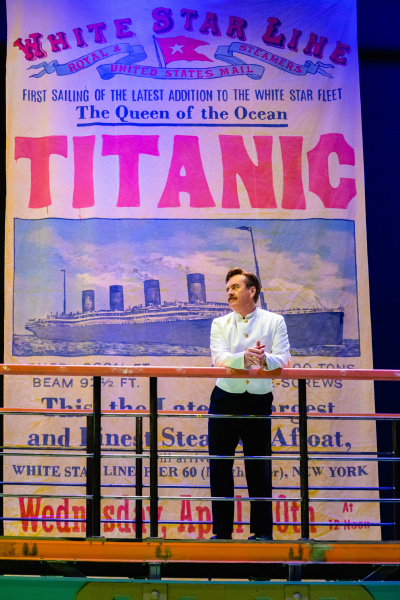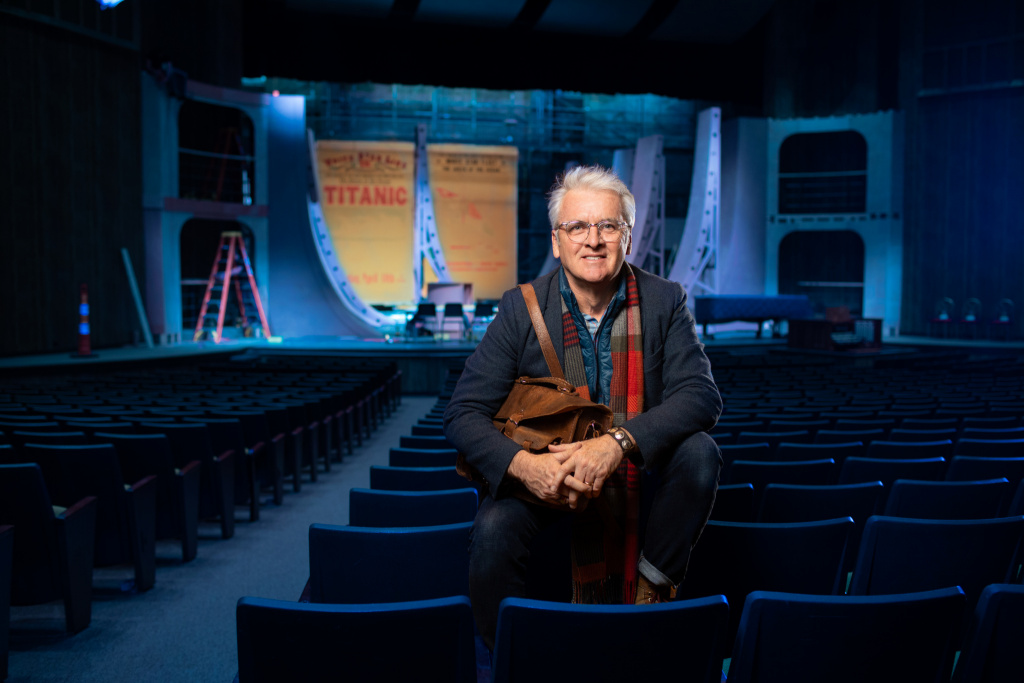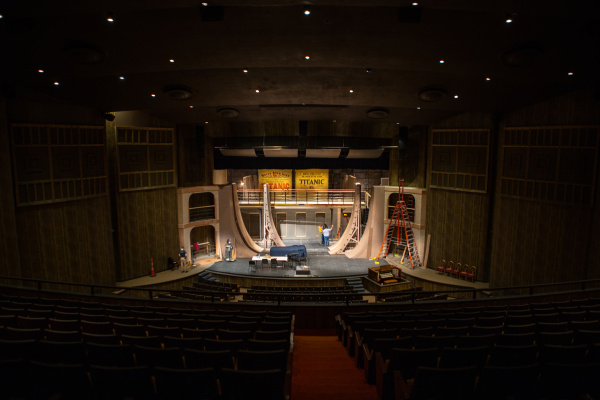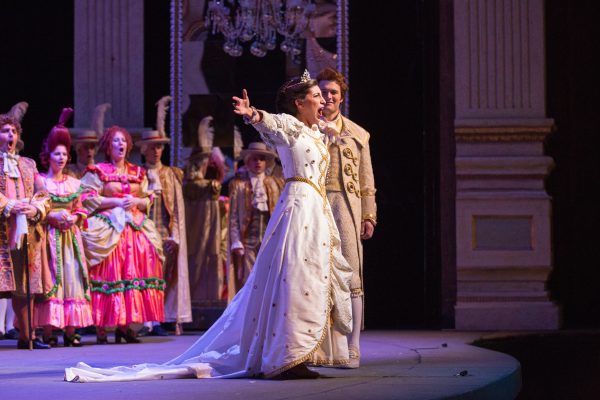Until now, you’ve mostly designed for plays and operas. How is designing a set for a musical different from those art forms?
One of my design teachers gave me the advice that Shakespeare plays should be designed like they’re Broadway musicals—scale, amount of stylization and so on. They’re not meant to be intimate, realistic sets for the most part. So, I guess I feel a little like I’ve been designing for musicals for quite a while. Of course, leaving enough floor space for choreography is different.
So much has been written and produced about the 1912 sinking of the RMS Titanic—books, movies, plays, etc. How did you begin your research for the scene design for the Titanic musical?
I started by searching images of the ship, which included interiors, exteriors—and what ended up being the most important part for me, the blueprints. I was fascinated with cross-sections of the hull. Those eventually helped inspire how the stage space got divided to create playing areas.
How do you look at a script and decide what’s going to influence your design?
First, I read the script just for entertainment—I get lost in the story. The second time I look for the broad strokes: Is the setting small and claustrophobic or big and expansive? Is it dark and dreary or bright and cheerful? From the third reading on, I’m looking for clues: what people say in the dialogue that will need to be represented on the set—what we call “obligatory clues.” If a scene calls for stoking a furnace, what exactly did the Titanic’s furnaces look like? How many were there? What kind of fuel did they use? Where was that done on the ship? How literally do we want to represent stoking the furnaces? Those clues lead to visual research. That research supports your clue list and informs the design choices you make. All that helps the audience go on the story’s journey with you.
I notice you say “informs” your choices. Does that mean sometimes you do your research and make a different choice?
Yes. Sometimes doing the historically accurate thing just won’t work for a production for one reason or another—expense, director’s preference, safety, scale—lots of possible reasons to make a choice other than what your research turns up. But good designers always do their homework, so their departures are purposeful and don’t unnecessarily distract and take audience members out of the story. In the furnace example mentioned before, we decided to stylize this part of the ship. You’ll have to come see what we ended up with.
Did you find out anything that surprised you during your research for Titanic?
I knew the Titanic was large, but I didn’t really understand the mass of the ship. It was about 2.5 football fields long. There were 3 million rivets in the hull. In the musical, there’s an opening trio that calls it “the largest moving object in the world.” And it really was at the time. That and how much “stuff” was onboard for the seven-day journey: 40,000 eggs. 13,000 grapefruit. 10,000 pounds of sugar. 12,000 dinner plates. 6,000 teaspoons. Facts like that let you know how truly massive it was.
Did you collaborate with the director on the design?
When Darren Lawson asked me to design the set, I listened to his ideas on how he thought the set might function. Then about a year ago, I came up with some initial ideas. I showed them to Darren, and we settled on one of them. Then I let that design incubate for several months. My initial idea was similar to how many scene designers of this show handle the set. But I kept going back to the shape of the hull and how it might “cradle” our playing space and give us some of the details—ropes, rivets, etc., of the ship, so I scrapped the first idea and went back to Darren with a new concept. And that’s where we ended up. I am much more excited about Titanic 2.0.
What have been the biggest challenges in designing the Titanic set?
One of the first things you notice during research is that the ship was so opulent and lavishly decorated that there’s no way to replicate all of it onstage. So instead I decided to focus on using scale to give the idea of the grandeur of the ship. That scale was another challenge: these are the highest and lowest playing spaces I’ve ever created for a show. The crow’s nest is way up there, and the radio room scene takes place below stage level. I had to find a way to use the stage most effectively for the various locations.
Is that what you find most exciting about design—the challenges?
Yes. I enjoy collaborating with other theater artists to solve challenges. Very often Rich Streeter, the lighting designer, saves me by helping to create a sense of locale that would otherwise be very difficult. Lighting can change a space into another space immediately, no waiting for a curtain to drop or a turntable to move. Solving challenges throughout the design process increases understanding of and appreciation for the piece.

Jeff Stegall as Henry Etches on the set of Titanic
You’re singing a role in Titanic, right?
Gulp. Yes. I am singing the role of Henry Etches, first-class steward. Mr. Etches is an actual historical figure. He was a steward on the Titanic, but he wasn’t the head steward. I guess the writers of the musical wanted my character to survive. In real life, the head steward, Andrew Latimer—who is a character named in the musical—did not.
Is this your first musical?
Actually, no. My first musical experience was at the Roxana (IL) High production of Carousel when I was a freshman or sophomore in high school. My best friend was in it, and he convinced me to ride a unicycle across the stage. Then in college I sang in a small chorus in Amahl and the Night Visitors at Welch College in Tennessee. But it’s definitely my first large-ish role.
How are you preparing for your role as Etches?
Well, I wanted to attend butler school at Blenheim Palace in England, but . . . Right now, I’m learning the music and receiving excellent coaching from Laura Brundage of BJU’s voice faculty. And lots of practice. I’m pretty much singing all of the time because this is waaaaaayy outside my comfort zone. We’ve been in rehearsal with entire cast on group songs for several weeks, and I’m having a blast. There are so many very talented student performers, and I’m enjoying watching them work. We’re all in the same room working through the musical score under Michael Moore’s first-rate direction. Next will come text work for my character’s spoken lines—a part of the process I’m much more comfortable with. We’re hoping Titanic will be as fun to watch as it’s been to work on.
See Also: Behind the Scenes of ‘Titanic’
Jeffrey Stegall has been directing, designing and acting for over 30 years. After earning a bachelor’s degree in Fine Arts at Welch College and a master’s degree in Oral Interpretation at Bob Jones University, he studied design at the University of Oklahoma and acting at the National Shakespeare Conservatory in New York City. He has played over 30 of Shakespeare’s roles including Hamlet, Henry V, Malvolio, Richard II, Iago, Touchstone, Caliban, Costard and Don Armado. His directing and design credits include over 50 plays and operas. He is co-founder of The Greenville Shakespeare Company, a non-profit theatre in South Carolina celebrating its 20th season next year.
He is the principal costume and scene designer for BJU’s Classic Players. He designed the set and costumes for the November 2018 production of King Lear, the set for the March 2019 production of Titanic, and the costumes for the April 2019 Living Gallery “Somewhere Forever.” He is also overseeing costume design for Titanic.
Special for BJUtoday by Kim Stegall








